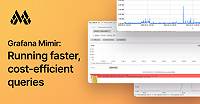Important: This documentation is about an older version. It's relevant only to the release noted, many of the features and functions have been updated or replaced. Please view the current version.
Configure Grafana Mimir object storage backend
Grafana Mimir can use different object storage services to persist blocks containing the metrics data, as well as recording rules and alertmanager state. The supported backends are:
- Amazon S3 (and compatible implementations like MinIO)
- Google Cloud Storage
- Azure Blob Storage
- Swift (OpenStack Object Storage)
Additionally and for non-production testing purposes, you can use a file-system emulated filesystem object storage implementation.
Ruler and alertmanager support a local implementation,
which is similar to filesystem in the way that it uses the local file system,
but it is a read-only data source and can be used to provision state into those components.
Common configuration
To avoid repetition, you can use the common configuration and fill the common configuration block or by providing the -common.storage.* CLI flags.
Note: Blocks storage cannot be located in the same path of the same bucket as the ruler and alertmanager stores. When using the common configuration, make
blocks_storageuse either a:
- different bucket, overriding the common bucket name
- storage prefix
Grafana Mimir will fail to start if you configure blocks storage to use the same bucket and storage prefix that the alertmanager or ruler store uses.
A valid configuration for the object storage (taken from the “Play with Grafana Mimir” tutorial) looks as follows:
common:
storage:
backend: s3
s3:
endpoint: minio:9000
access_key_id: mimir
secret_access_key: supersecret
insecure: true
bucket_name: mimir
blocks_storage:
storage_prefix: blocksNote: If you’re using a mixture of YAML files and CLI flags, pay attention to their precedence logic.


